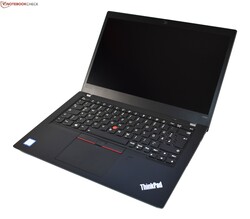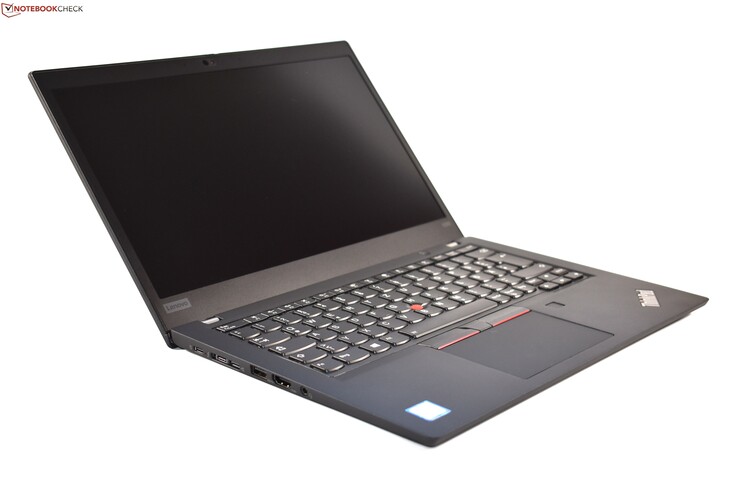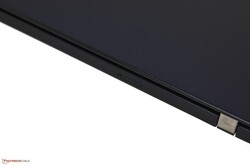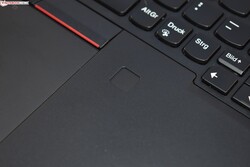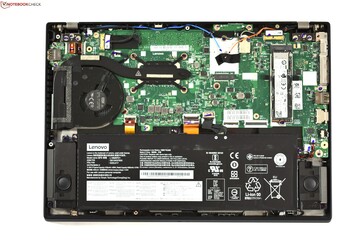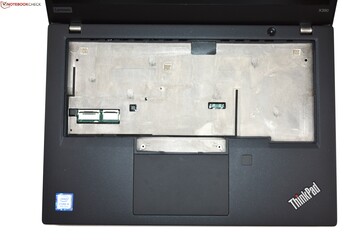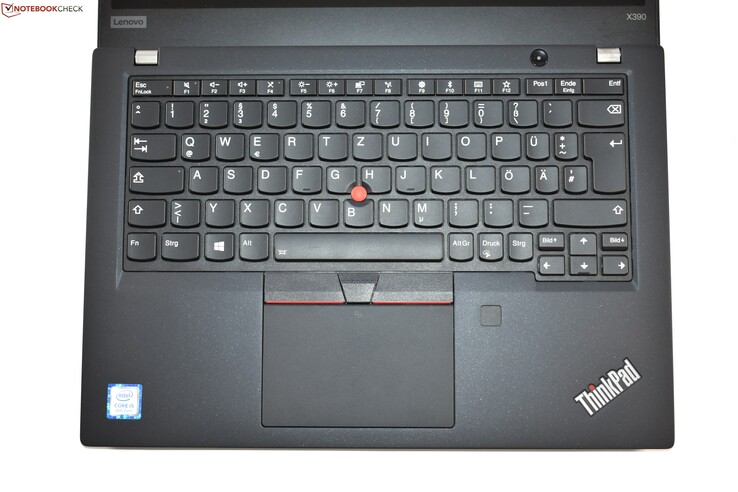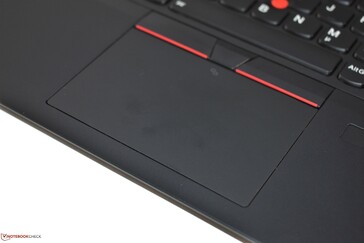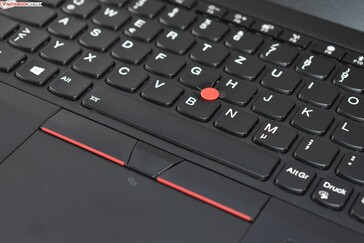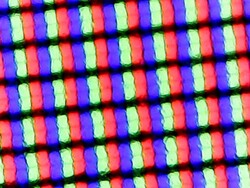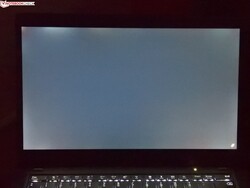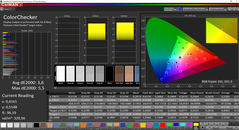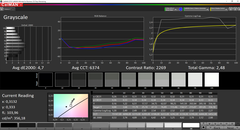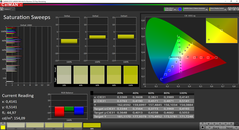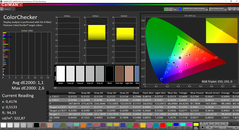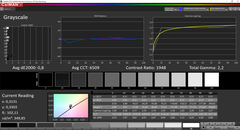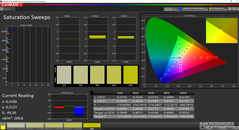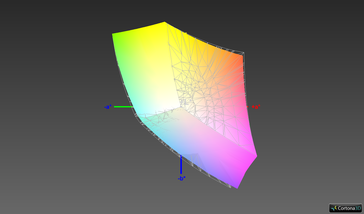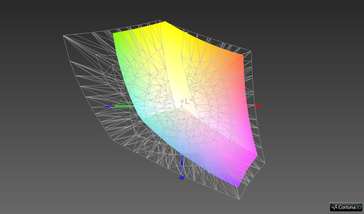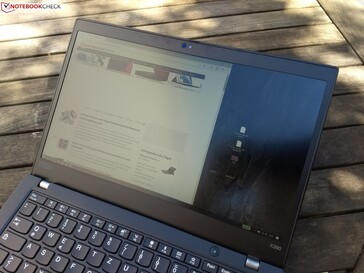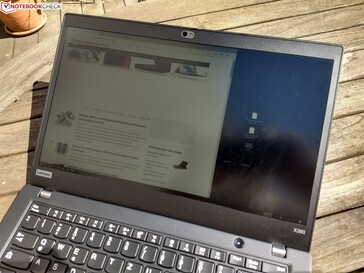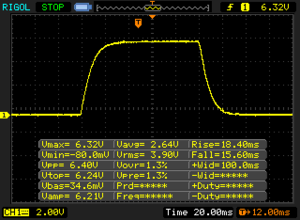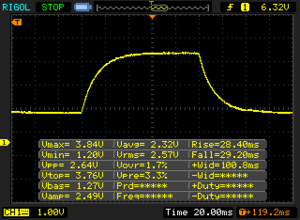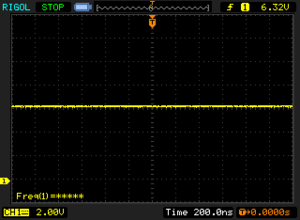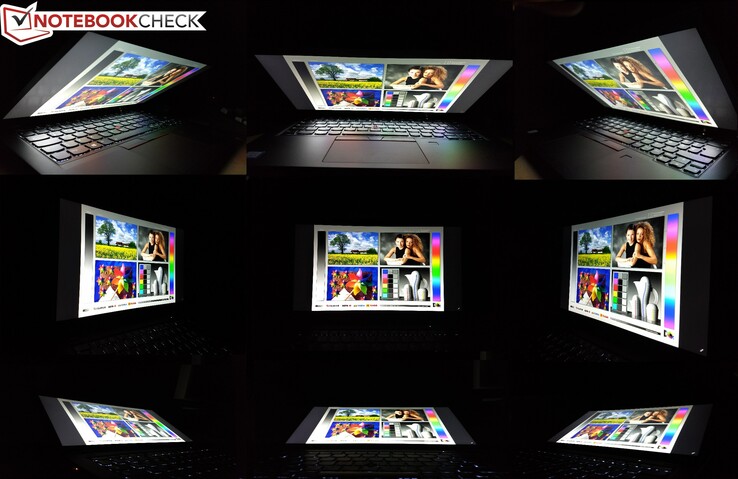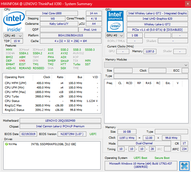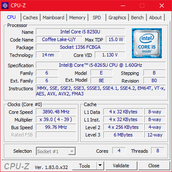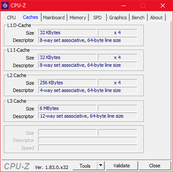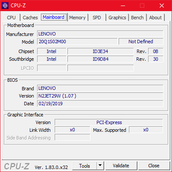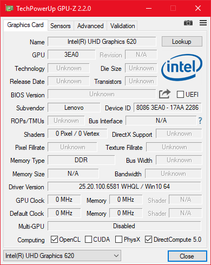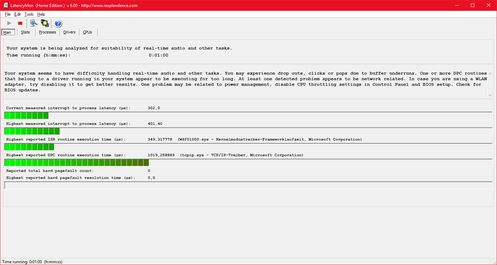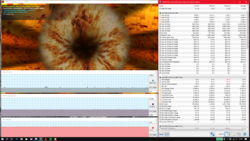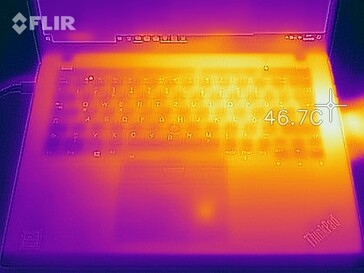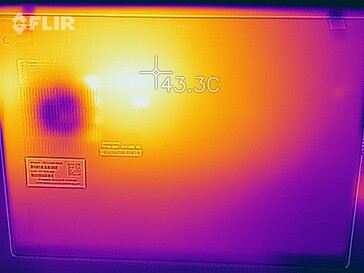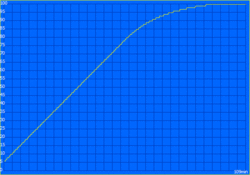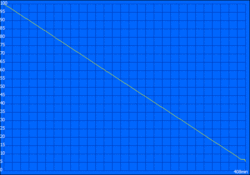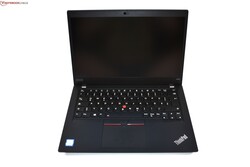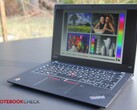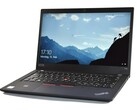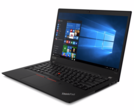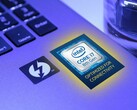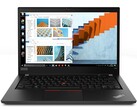Lenovo ThinkPad X390 (i5-8265U, FHD) Laptop Review

Since Lenovo acquired IBM's PC business in 2005, one thing has always been true: The ThinkPad X series had a 12-inch screen, while the ThinkPad T series always contained a 14-inch screen as the smallest option. From 2008 onward, Lenovo sold the smallest ThinkPad as the ThinkPad X200 series, which has spawned several popular models over the years, like the Lenovo ThinkPad X220 from 2011. Last year's model of this series was the Lenovo ThinkPad X280, the thinnest and lightest model of the X200 series, which was the first X-series ThinkPad that lacked features like an external battery or upgradeable RAM.
With this in mind, it is not possible to say that Lenovo was not willing to change up things to keep the most compact ThinkPad relevant in an ever-changing laptop market. Still, it was no secret even last year that the 12.5-inch form-factor of the X280 had no future. The screen bezels of this model were very large for a modern laptop and one of the most important competitors discontinued its 12.5-inch business series – HP released the EliteBook 830 G5 with a 13.3-inch screen instead of an EliteBook 820 G5. Lenovo had to react and the reaction came in 2019: The successor of the ThinkPad X280 is named Lenovo ThinkPad X390, a compact business laptop with a 13.3-inch screen.
This increase in screen size of course results in an X-series ThinkPad that is closer to the larger T series than before. Especially compared with the Lenovo ThinkPad T490s, we have to ask the question if it is even necessary to have those two ThinkPads as separate models – maybe there are not enough differences left to justify the segmentation. Also, there still is the Lenovo ThinkPad X1 Carbon, which has a similar feature-set as well. Aside from those two Lenovo ThinkPads, we use the HP EliteBook 830 G5 and Dell Latitude 7390 for our comparisons.
Our review unit originated from the German Lenovo Campus program. This special configuration is exclusively available for students and teachers and costs 1,159 Euros (~$1,300). For this price, the ThinkPad X390 contains the Core i5-8265U, 16 GB RAM, a 512 GB SSD and an FHD display. Windows is not preinstalled on this special model. A similar configuration with Windows costs roughly 1,500 Euros (~$1,682) in Germany. In the US, such a configuration of the X390 (which also includes three years of Premier warranty) costs $1,535.
Case
The section about the case can be summed up with "many things stay as they were before". Lenovo does not change the basic design of the ThinkPad X280 – this was to be expected, as last year's model already introduced a new design. The ThinkPad X390 looks like many other recent ThinkPad laptops of the T series and the X1 Carbon: The base-unit has a slight wedge design and the screen is held in place by two small drop-down hinges. Of course, a relevant difference compared with the preceding model is the much smaller screen bezels. This makes the X390 look a lot more modern and more attractive, though the ThinkPad X1 Carbon still has smaller screen bezels. Like all ThinkPads, the ThinkPad X390 has a black chassis with some little hints of color like the red TrackPoint or the silver hinges. Different from the ThinkPad T490s, there is no option for a silver case.
In terms of materials, Lenovo uses a similar mix like with the ThinkPad X280. The base unit is completely made out of magnesium, which is painted matte black. The screen cover is painted matte black as well, but the material beneath the paint is not magnesium. There are two options for the material of the display lid: Either a Carbon-Fiber Reinforced Plastic (CFRP) or a Glass-Fiber Reinforced Plastic (GFRP) lid. Our review unit has the GFRP lid, which is another difference compared with the ThinkPad X280, which we tested with the CFRP lid. Even with the cheaper lid material, the chassis absolutely convinces us in terms of quality: The materials have a very nice feel to them, the stability is very good in all areas and we did not discover any obvious build quality problems.
The small hinges with metal caps hold the screen tightly and allow an opening angle of 180°. It is not possible to open the screen with one hand.
Unfortunately, Lenovo did not manage to put in the larger 13.3-inch screen into the chassis of the ThinkPad X280 without making it a little bit bigger. Naturally, this means that the size difference compared with the ThinkPad T490s and the ThinkPad X1 Carbon has become smaller. Especially the X1 Carbon is almost as compact. It is only slightly wider, but it contains a 14-inch LCD. The Dell Latitude 7390 proves that it is possible to put a 13.3-inch screen into an even smaller footprint – the HP EliteBook 830 G5 on the other hand is a little bit bigger than the ThinkPad X390.
What is true for the size holds true for the weight as well: The X390 is heavier than the X280, which only weighed 1.13 kg with the CFRP lid. The X390 with the CFRP lid weighs 1.22 kg and our review unit with the GFRP lid weighs 1.29 kg. In terms of weight, this means that the X390 is almost as heavy as the ThinkPad T490s and the other 13.3-inch business laptops. The X1 Carbon on the other hand is much lighter with just 1.1 kg.
Connectivity
Lenovo keeps the solid port selection of the ThinkPad X280, though this also means that the X390 is still missing a full-size RJ45 port – instead, users have to rely on Lenovo's proprietary miniEthernet port to get a native Ethernet connection. Of the two USB ports of the X390, only the one to the right supports Thunderbolt 3. Since this is a 2x PCIe lane port, the X390 can only drive one 4K UHD monitor with 60 Hz via any of the docks that Lenovo offers. Only the ThinkPad X1 Carbon can drive two 4K UHD screens with 60 Hz, as its two Thunderbolt ports are connected via four PCIe lanes.
SD card reader
Unfortunately, Lenovo did not change the positioning of the microSD card reader on the back of the system. It is extremely hard to reach, as the display has to be closed and the user first has to open the slot, which hides the SIM slot as well. Thus, the microSD card is usable for permanent storage expansion, but it is not usable in everyday use as an SD card reader.
We measured the performance of the card reader with the Toshiba Exceria Pro M501 microSD card and it delivers an average performance. The SD card reader in the ThinkPad X1 Carbon 2018 is as difficult to reach, but it is much faster. The microSD card reader of the Dell Latitude 7390 is easier to reach and faster. The HP EliteBook 830 G5 meanwhile has no SD card reader at all.
| SD Card Reader | |
| average JPG Copy Test (av. of 3 runs) | |
| Lenovo ThinkPad X1 Carbon 2018-20KGS03900 (Toshiba Exceria Pro M501) | |
| Dell Latitude 7390 (Toshiba Exceria Pro M501) | |
| Lenovo ThinkPad X390-20Q1S02M00 (Toshiba Exceria Pro M501) | |
| Lenovo ThinkPad X280-20KES01S00 (Toshiba Excerie Pro M501) | |
| Lenovo ThinkPad T490s-20NYS02A00 (Toshiba Exceria Pro M501) | |
| Average of class Subnotebook (18.4 - 142, n=13, last 2 years) | |
| maximum AS SSD Seq Read Test (1GB) | |
| Lenovo ThinkPad X1 Carbon 2018-20KGS03900 (Toshiba Exceria Pro M501) | |
| Dell Latitude 7390 (Toshiba Exceria Pro M501) | |
| Lenovo ThinkPad T490s-20NYS02A00 (Toshiba Exceria Pro M501) | |
| Lenovo ThinkPad X390-20Q1S02M00 (Toshiba Exceria Pro M501) | |
| Lenovo ThinkPad X280-20KES01S00 (Toshiba Excerie Pro M501) | |
| Average of class Subnotebook (22.5 - 207, n=13, last 2 years) | |
Communication
It is typical for true business systems to offer a large amount of communication modules. The ThinkPad X390 fulfills this role flawlessly. Our review unit for example contains the 2x2 Wi-Fi card Intel Wireless AC 9560 (which support Bluetooth 5.0 as well), the Ethernet module Intel I219-V and an NFC module. Optionally, the X390 is available with an LTE card, too. The review sample contained the necessary antennas, which means that it is possible to add on LTE as an after-market upgrade. Later this year, Lenovo will offer another option when it comes to communication: The Intel Wireless AX 22260, one of the first Wi-Fi modules with the new Wi-Fi 6 standard.
The microphones and the webcam are as bad as those components typically are on laptops. They suffice for video telephony, but they are just too poor for all other tasks.
Security
Security is one of the basic virtues of a business laptop. The Lenovo X390 has a touch fingerprint reader, as smartcard reader, a Kensington lock slot, an infrared camera for Windows Hello and the mechanical camera shutter "ThinkShutter". Besides those hardware features, the Lenovo laptop has TPM and the anti-theft solution Computrace as well.
Compared with the Lenovo ThinkPad X280, there are two changes: Lenovo has removed the LED of the fingerprint reader, which informed the user if the system is ready to be unlocked via the fingerprint reader. Second, the ThinkShutter is now a feature on all models – with last year's models the ThinkShutter was only featured if the system was configured without the infrared camera.
Accessories
Aside from the Lenovo ThinkPad X390 itself, only the 65 W USB C charger is included as part of the package. Optionally, it is possible to choose from a variety of compatible docking stations from Lenovo. A USB C dock, a Thunderbolt 3 dock (both of which are connected via a cable) and three proprietary mechanical docks for the side-docking port are available. The best of these is the ThinkPad CS18 Ultra dock.
Maintenance
It is not very difficult to gain access to the insides of the Lenovo ThinkPad X390. To remove the bottom cover, it is necessary to loosen five screws. The bottom cover lifts up slightly as soon as the screws are loose and then the user has to use a spudger to disengage the cover from the base unit. As soon as the cover is removed, it is possible to replace components like the battery, clean the fan or to replace the thermal paste. So maintenance is easy, but the ThinkPad X390 is not very upgradeable. The RAM is soldered down for example, exactly as it was on the predecessor. The Wi-Fi module is now soldered down as well, as Lenovo uses the new Intel CNVI technology, which means that part of the Wi-Fi module is now integrated into the CPU. At least the M.2 2280 SSD is still upgradeable, as is the WWAN LTE module. The needed WWAN antennas are built-in in our review model, though this might not be the case with every model of the X390.
An interesting fact that we want to highlight: The keyboard of the ThinkPad X390 is easily removable and replaceable. To do this, it is only necessary to loosen two screws that are hidden beneath the TrackPoint buttons (which can be removed without breaking them) and then slide the keyboard backwards to unlock and remove it. Neither the Lenovo ThinkPad X1 Carbon nor the ThinkPad T490s offer this feature; both of them have to be almost completely disassembled to remove the keyboard. This feature enables users to replace the built-in keyboard with another keyboard with a different layout. For example, some users in Germany prefer the QWERTY ANSI layout used in the USA instead of the QWERTZ ISO layout used here in Germany. Changing the layout after the fact is easily possible with the X390.
Warranty
Ex factory, our review sample of the Lenovo ThinkPad X390 has a three-year warranty. The warranty package includes on-site service and Premier support as well, which promises a faster warranty service. Even with this good warranty package, it is still possible to purchase warranty upgrades such as a five-year warranty or accidental damage protection, which covers additional damages.
Input devices
Keyboard
The backlit keyboard of the Lenovo ThinkPad X390 is pretty much exactly the keyboard that Lenovo used in the predecessor Lenovo ThinkPad X280. This means that the X390 contains a six-row chiclet keyboard, which is shrunk down compared with the keyboards used in the ThinkPad T490s or ThinkPad X1 Carbon. This means that the keyboard is less wide – as a result, several keys are smaller than normal. Notably so are the three smaller keys to the right of the spacebar as well as the four smaller keys to the left of the Return key. In everyday use, the smaller layout can require some acclimatization – though this might now be the case if the user is used to smaller layouts like the one of the Dell XPS 13 anyway.
In terms of the typing experience, the Lenovo ThinkPad X390 manages to satisfy the high exceptions that we have when it comes to ThinkPad keyboards. The slightly concave chiclet keys have a key travel of roughly 1.7 mm with a very comfortable pressure point – typing long texts on this keyboard is a joy, at least if you have gotten used to the shrunken keyboard. It should be noted that Lenovo uses keyboards from different parts-manufacturers in the ThinkPad X390, like in most ThinkPads. There are keyboards from Chicony, LiteOn or Primax listed in the parts list, so the typing experience may vary.
Touchpad + TrackPoint
After Lenovo had enlarged the touchpad of the ThinkPad X280 quite drastically compared with the 2017 model ThinkPad X270, the touchpad has become larger again with the X390 – the usable touch-surface measures 10 x 6.5 cm, which means the touchpad is 1 cm deeper than before. This touchpad size is absolutely adequate for a laptop of this size and helps in everyday use, especially when using gestures. Lenovo clearly prioritized a larger touchpad surface, which is why the touchpad buttons are integrated into the trackpad. The integrated keys work flawlessly, though the key-mechanism of the ClickPad is slightly squishy on our model. Like with all ThinkPads apart from the X1 models, the touchpad is made out of plastic. This solution does not feel as nice as glass, but it does not really affect the user experience in a bad way, as the surface is smooth enough. All things considered, the touchpad is very usable and thanks to the Microsoft Precision Touchpad driver, there is nothing to complain about the software, either.
Additionally, the Lenovo ThinkPad X390 of course features the typical ThinkPad TrackPoint. The TrackPoint only remains on certain business laptop lines these days, but once you have gotten used to this input device, it becomes hard to use a laptop without one. Especially when working with the keyboard, the TrackPoint still has its unique advantages, as it allows users to keep their hands on the keyboard when they have to move the cursor. The TrackPoint, which was made by ELAN on our review sample, is extremely precise and the three dedicated buttons beneath the keyboard have the ideal position and size. Their travel is short, their pressure point defined and the buttons are pretty quiet.
Display
There are four different 13.3-inch screen options for the ThinkPad X390. They are important differentiators to other ThinkPads like the T490s and the X1 Carbon. Different from those models, it still is possible to buy the ThinkPad X390 with an HD TN screen (1366x768). This lowers the base price, and thus many corporate buyers will choose this option, but in terms of screen quality, this option is absolutely not recommendable. As a higher resolution, the only choice is FHD (1920x1080) – the 14-inch model ThinkPad T490s offers QHD (2560x1440), as does the ThinkPad X1 Carbon 2018. The upcoming ThinkPad X1 Carbon 2019 will even be available with a 4K UHD screen (3240x2160).
Choosing the ThinkPad X390 means choosing an FHD resolution at best. There are three different screens with said FHD resolution. All three are matte and based on IPS technology. Two of the screens are supposed to reach 300 cd/m², the third 400 cd/m². The brightest screen is a ThinkPad PrivacyGuard display with a built-in ePrivacy solution. There also are differences between the other two FHD LCDs: One of them supports touch, the other one does not.
The sample device we are testing contains the FHD screen without touch and has a brightness value of 300 cd/m². In practice, the LG LP133WF7-SPB1 panel exceeds this value. On average, we measured 335 cd/m². This panel is brighter than the 12.5-inch screen of the ThinkPad X280 or the FHD screen of the X1 Carbon 2018, but the ThinkPad T490s contains a brighter FHD LCD. It also has to be noted that there is no guarantee to receive a screen that is brighter than 300 cd/m² – the parts list of the X390 has three other non-touch FHD IPS screens with 300 cd/m² – alternatively, there are LCD panels made by BOE, AUO and Innolux. The buyer plays the LCD parts-lottery.
There is almost no backlight bleeding visible and the brightness is evenly spread as well. The panel does not use PWM to regulate the brightness.
| |||||||||||||||||||||||||
Brightness Distribution: 88 %
Center on Battery: 355 cd/m²
Contrast: 2225:1 (Black: 0.16 cd/m²)
ΔE ColorChecker Calman: 3.6 | ∀{0.5-29.43 Ø4.78}
calibrated: 1.1
ΔE Greyscale Calman: 4.7 | ∀{0.09-98 Ø5}
95.7% sRGB (Argyll 1.6.3 3D)
61.3% AdobeRGB 1998 (Argyll 1.6.3 3D)
66.6% AdobeRGB 1998 (Argyll 3D)
95.9% sRGB (Argyll 3D)
65.3% Display P3 (Argyll 3D)
Gamma: 2.48
CCT: 6374 K
| Lenovo ThinkPad X390-20Q1S02M00 LP133WF7-SPB1, , 1920x1080, 13.3" | Lenovo ThinkPad X280-20KES01S00 B125HAN02.2, , 1920x1080, 12.5" | Lenovo ThinkPad T490s-20NYS02A00 B140HAN05.7, , 1920x1080, 14" | Lenovo ThinkPad X1 Carbon G6-20KG0025UK Lenovo LEN40A9 / AUO B140HAK02.3, , 1920x1080, 14" | HP EliteBook 830 G5-3JX74EA IVO M133NVF3-R0, , 1920x1080, 13.3" | Dell Latitude 7390 AU Optronics AUO462D / B133HAN [DELL P/N:F7VDJ], , 1920x1080, 13.3" | |
|---|---|---|---|---|---|---|
| Display | -33% | 3% | 3% | -4% | -2% | |
| Display P3 Coverage (%) | 65.3 | 44 -33% | 67.1 3% | 68.3 5% | 64.2 -2% | 65.1 0% |
| sRGB Coverage (%) | 95.9 | 64.5 -33% | 97.6 2% | 94.9 -1% | 89.2 -7% | 90.8 -5% |
| AdobeRGB 1998 Coverage (%) | 66.6 | 45.45 -32% | 68.5 3% | 69.3 4% | 65.2 -2% | 65.9 -1% |
| Response Times | 22% | -11% | 29% | 32% | 6% | |
| Response Time Grey 50% / Grey 80% * (ms) | 57.6 ? | 40 ? 31% | 61.6 ? -7% | 40 ? 31% | 36 ? 37% | 48.8 ? 15% |
| Response Time Black / White * (ms) | 34 ? | 29.6 ? 13% | 38.8 ? -14% | 25 ? 26% | 24.8 ? 27% | 35.2 ? -4% |
| PWM Frequency (Hz) | 1020 ? | |||||
| Screen | -41% | -0% | -2% | -36% | -25% | |
| Brightness middle (cd/m²) | 356 | 344 -3% | 391 10% | 298 -16% | 316 -11% | 329 -8% |
| Brightness (cd/m²) | 336 | 313 -7% | 389 16% | 287 -15% | 326 -3% | 316 -6% |
| Brightness Distribution (%) | 88 | 82 -7% | 87 -1% | 91 3% | 85 -3% | 92 5% |
| Black Level * (cd/m²) | 0.16 | 0.25 -56% | 0.23 -44% | 0.2 -25% | 0.19 -19% | 0.25 -56% |
| Contrast (:1) | 2225 | 1376 -38% | 1700 -24% | 1490 -33% | 1663 -25% | 1316 -41% |
| Colorchecker dE 2000 * | 3.6 | 4.7 -31% | 3.4 6% | 2.19 39% | 4.5 -25% | 4.3 -19% |
| Colorchecker dE 2000 max. * | 5.5 | 19.4 -253% | 4.7 15% | 4.39 20% | 12.1 -120% | 7.8 -42% |
| Colorchecker dE 2000 calibrated * | 1.1 | 1.1 -0% | 1.67 -52% | 2.9 -164% | 2.5 -127% | |
| Greyscale dE 2000 * | 4.7 | 2.2 53% | 4 15% | 1.97 58% | 5 -6% | 3.6 23% |
| Gamma | 2.48 89% | 2.16 102% | 2.49 88% | 2.43 91% | 2.22 99% | 2.43 91% |
| CCT | 6374 102% | 6252 104% | 6809 95% | 6571 99% | 6018 108% | 6928 94% |
| Color Space (Percent of AdobeRGB 1998) (%) | 61.3 | 41.2 -33% | 62.4 2% | 62 1% | 57.9 -6% | 59.1 -4% |
| Color Space (Percent of sRGB) (%) | 95.7 | 64.1 -33% | 97.4 2% | 95 -1% | 87.3 -9% | 90.6 -5% |
| Total Average (Program / Settings) | -17% /
-31% | -3% /
-1% | 10% /
3% | -3% /
-21% | -7% /
-17% |
* ... smaller is better
Ex factory, there are some deviations in terms of color-values and grayscale. There was no color tint. With calibration, we were able to correct the small deviations. The color profile used here is available for free, as always. When calibrated, the screen really does have a very good subjective image quality. The contrast value of 2225:1 is excellent, and it is a result of the low black value of just 0.16 cd/m². The only negative thing about this panel is the bad response times – but in everyday use, we only noticed that the mouse cursor seemed to leave a "trace" that disappeared after a few milliseconds.
A huge difference compared with the ThinkPad X280 is the much better color gamut. While this model has a very poor sRGB coverage of just 64.1%, the screen of the ThinkPad X390 reaches 95.7%. This means that the smallest ThinkPad is usable for semi-professional photo-editing as well.
The matte surface and the good brightness value are responsible for making this LCD panel outdoor-usable. It is usable in the shadow as well as the sun, though direct sunlight on the screen should still be avoided – for that, the panel would need to be a lot brighter.
Display Response Times
| ↔ Response Time Black to White | ||
|---|---|---|
| 34 ms ... rise ↗ and fall ↘ combined | ↗ 18.4 ms rise | |
| ↘ 15.6 ms fall | ||
| The screen shows slow response rates in our tests and will be unsatisfactory for gamers. In comparison, all tested devices range from 0.1 (minimum) to 240 (maximum) ms. » 90 % of all devices are better. This means that the measured response time is worse than the average of all tested devices (20.2 ms). | ||
| ↔ Response Time 50% Grey to 80% Grey | ||
| 57.6 ms ... rise ↗ and fall ↘ combined | ↗ 28.4 ms rise | |
| ↘ 29.2 ms fall | ||
| The screen shows slow response rates in our tests and will be unsatisfactory for gamers. In comparison, all tested devices range from 0.165 (minimum) to 636 (maximum) ms. » 94 % of all devices are better. This means that the measured response time is worse than the average of all tested devices (31.6 ms). | ||
Screen Flickering / PWM (Pulse-Width Modulation)
| Screen flickering / PWM not detected | |||
In comparison: 53 % of all tested devices do not use PWM to dim the display. If PWM was detected, an average of 8108 (minimum: 5 - maximum: 343500) Hz was measured. | |||
Performance
The Lenovo ThinkPad X390 is still in the middle of its release process, which means that not all configurations are available yet. In principle, the ThinkPad subnotebook will be offered with a number of Intel processors. These are the Intel Core i5-8265U and the Core i7-8565U as well as their vPro counterparts (Core i5-8365U and Core i7-8665U). Additionally, the ThinkPad X390 is also configurable with the Core i3-8145U. This cheaper processor is not available for the X1 Carbon or the T490s. The RAM is completely soldered on-board in the ThinkPad X390. Lenovo offers 8 or 16 GB DDR-2400 RAM at the moment. When the Intel Core i7-8665U is available, there is going to be a 32 GB option as well, which will be limited to this processor. As mass storage, all X390 models use SSDs with a capacity of 128, 256, 512 GB or 1 TB. In all configurations, the Intel UHD Graphics 620 serves as the GPU.
Processor
The Intel Core i5-8265U is a quad-core processor of the Whiskey Lake series. Its four cores have a clock-rate of 1.6 to 3.9 GHz and they consume a maximum of 15 W. Comparisons with other processors are possible with our CPU benchmark list.
In the Cinebench R15 multicore test, the processor can consume more than 15 W. The Lenovo ThinkPad X390 allows a maximum power consumption of up to 43 W, but only for a few seconds. The CPU temperatures quickly reach 98 °C. The power consumption starts to plummet to 32 W and after 30 seconds to 25 W. The CPU clock-rate follows suit, falling to 3.7 GHz and then to 3.3 GHz. In the Cinebench loop the processor can keep up this clock-rate for two minutes. Afterwards, the power consumption is limited to 20 W and the clock-rate falls to 2.6 GHz. The ThinkPad X390 can hold this level of performance for the remainder of the Cinebench loop with some slight up- and down-movements.
While the boost performance of the X390 equals the older ThinkPad X280, the X390 manages to keep its performance on a higher level under sustained load. The HP EliteBook 830 G5 is a little bit slower as well, while there are almost no differences compared with the Dell Latitude 7390. The ThinkPad X1 Carbon 2018 is faster than the ThinkPad X390, no matter if it is undervolted or not.
When the device is being used on battery power, the CPU performance is limited. Instead of 42 W, the CPU has a maximum power consumption of 25 W. This means that the system reaches 530 points in the Cinebench R15 multicore test.
System performance
The Lenovo ThinkPad X390 is an exceedingly fast PC. In everyday use, there are no unnecessary interruptions and in the PCMark benchmarks the system performs well, too. This holds true for both the old PCMark 8 and the newer PCMark 10.
| PCMark 8 Home Score Accelerated v2 | 3629 points | |
| PCMark 8 Work Score Accelerated v2 | 4896 points | |
| PCMark 10 Score | 3832 points | |
Help | ||
Storage solution
A single M.2 2280 SSD serves as the storage of the Lenovo ThinkPad X390. Our model includes a PCIe NVMe SSD made by Intel with a capacity of 512 GB. However, this only holds true for our review unit, since the same parts-lottery that we noticed with the screen affects the SSD as well. In the parts list of the ThinkPad X390, there are 28 (!) different 512 GB SSDs listed.
The Intel SSD in our review unit is not a slow one in any case. The Samsung PM981 that we tested in last year's ThinkPad X280 is faster, but the difference is rather small.
| Lenovo ThinkPad X390-20Q1S02M00 Intel SSD Pro 7600p SSDPEKKF512G8L | Lenovo ThinkPad X280-20KES01S00 Samsung SSD PM981 MZVLB512HAJQ | Lenovo ThinkPad X1 Carbon 2018-20KGS03900 Samsung SSD PM981 MZVLB512HAJQ | HP EliteBook 830 G5-3JX74EA Samsung SSD PM961 1TB M.2 PCIe 3.0 x4 NVMe (MZVLW1T0) | Dell Latitude 7390 Samsung PM961 MZVLW256HEHP | Average Intel SSD Pro 7600p SSDPEKKF512G8L | |
|---|---|---|---|---|---|---|
| CrystalDiskMark 5.2 / 6 | 11% | 9% | -1% | 13% | 6% | |
| Write 4K (MB/s) | 120.7 | 125.3 4% | 131.9 9% | 108.5 -10% | 139.4 15% | 133.9 ? 11% |
| Read 4K (MB/s) | 58.5 | 43.5 -26% | 44.6 -24% | 40.53 -31% | 43.18 -26% | 59.1 ? 1% |
| Write Seq (MB/s) | 1491 | 112 -92% | 1824 22% | 1026 -31% | 1075 -28% | 1378 ? -8% |
| Read Seq (MB/s) | 2760 | 2273 -18% | 2163 -22% | 2080 -25% | 1639 -41% | 2341 ? -15% |
| Write 4K Q32T1 (MB/s) | 237.5 | 641 170% | 338.1 42% | 451 90% | 662 179% | 355 ? 49% |
| Read 4K Q32T1 (MB/s) | 336.1 | 392 17% | 351.9 5% | 269.7 -20% | 413.9 23% | 429 ? 28% |
| Write Seq Q32T1 (MB/s) | 1512 | 1903 26% | 1972 30% | 1770 17% | 1195 -21% | 1514 ? 0% |
| Read Seq Q32T1 (MB/s) | 3154 | 3398 8% | 3387 7% | 3214 2% | 3116 -1% | 2677 ? -15% |
GPU
The Intel UHD Graphics 620 is an integrated GPU, which is the standard in all Kaby Lake Refresh and Whiskey Lake processors. For this GPU with its 24 execution units, the main system memory is extremely important, as the GPU lacks its own dedicated memory. Since the memory in the X390 is soldered down in a dual-channel configuration in all models, the GPU is always able to achieve its complete potential. Still, no-one should expect wonders from this GPU. The Intel graphics chip is still very slow.
The GPU performance is not negatively affected when the device is running on battery power.
| 3DMark 11 Performance | 2062 points | |
| 3DMark Cloud Gate Standard Score | 8361 points | |
| 3DMark Fire Strike Score | 1115 points | |
Help | ||
Gaming performance
The gaming performance of the Lenovo ThinkPad X390 is almost not worth mentioning. This business laptop is able to display older games, but only on reduced graphical details. Recent games are not or barely playable. Of course, the small ThinkPad subnotebook is not made for these tasks in any way.
Still, the potential exists to transform the compact ThinkPad laptop into a gaming PC, thanks to Thunderbolt 3. It is possible to connect any eGPU, though some performance loss can be expected when using extremely fast external GPUs, due to the two-lane PCIe connection of the Thunderbolt port.
| low | med. | high | ultra | |
|---|---|---|---|---|
| BioShock Infinite (2013) | 79.3 | 37.4 | 31.3 | 10.3 |
| The Witcher 3 (2015) | 16.9 | |||
| Rise of the Tomb Raider (2016) | 25.7 | 14.9 | ||
| Civilization 6 (2016) | 54.4 | 20.3 | ||
| F1 2018 (2018) | 33 | 15 |
Emissions
Noise
The fan is completely turned off in idle – this is what we expect, as it should be off when an office system is barely used. Under load, the fan runs constantly with 34.8 dB(A), which is neither extremely loud nor extremely annoying. The competitor from Dell, the Latitude 7390, has a more annoying fan.
We did not hear coil-whine with this Lenovo ThinkPad X390. If the ear is held directly to the keyboard, it is possible to hear a sizzling sound, though this really is extremely quiet.
Noise level
| Idle |
| 29.2 / 29.2 / 29.2 dB(A) |
| Load |
| 34.8 / 34.8 dB(A) |
 | ||
30 dB silent 40 dB(A) audible 50 dB(A) loud |
||
min: | ||
Temperatures
The outer temperatures of the Lenovo ThinkPad X390 are fine. The chassis temperatures reach 44.6 °C, an unproblematic value. It should be noted that the palm-rest does not stay completely cool – other laptops manage to always keep their cool in this area.
In the stress test with Prime95 and FurMark, the ThinkPad X390 is able to consume 38 W, which allows all four CPU cores to reach a clock-rate of 3.1 GHz. The result: The CPU temperatures climb to 96 °C. After 30 seconds, the consumption is limited to 25 W, which means the CPU clock-rate falls to 1.3 GHz and the temperatures fall to 78 °C. The system can keep up this level of performance for 10 minutes; afterwards, the power consumption is limited to 17 W. The CPU clock-rate just reaches 1 GHz when this happens. Temperatures remain stable at 70 °C. This situation does not change for the remaining stress test.
So we were able to measure throttling, as the CPU clock-rate sank below the base-clock. This throttling should not be an issue in everyday use however, as the 3Dmark 11 test after the stress test produced a normal result.
(±) The maximum temperature on the upper side is 44.6 °C / 112 F, compared to the average of 35.9 °C / 97 F, ranging from 21.4 to 59 °C for the class Subnotebook.
(±) The bottom heats up to a maximum of 41.1 °C / 106 F, compared to the average of 39.3 °C / 103 F
(+) In idle usage, the average temperature for the upper side is 22.8 °C / 73 F, compared to the device average of 30.8 °C / 87 F.
(+) The palmrests and touchpad are reaching skin temperature as a maximum (32.8 °C / 91 F) and are therefore not hot.
(-) The average temperature of the palmrest area of similar devices was 28.2 °C / 82.8 F (-4.6 °C / -8.2 F).
Speakers
As with many ThinkPad laptops of the last years, Lenovo places the speakers of the ThinkPad X390 at the bottom of the system. The stereo speakers are not bad, but they are not really good, either. For that, they are not loud enough and the bass is completely missing. At least they do not tend to distort on their highest loudness level.
Instead of the speakers, we recommend the combo audio port, which puts out sound to external speakers or headphones with no issues.
Lenovo ThinkPad X390-20Q1S02M00 audio analysis
(±) | speaker loudness is average but good (72.6 dB)
Bass 100 - 315 Hz
(-) | nearly no bass - on average 20.8% lower than median
(±) | linearity of bass is average (13.6% delta to prev. frequency)
Mids 400 - 2000 Hz
(+) | balanced mids - only 2.3% away from median
(+) | mids are linear (5.5% delta to prev. frequency)
Highs 2 - 16 kHz
(+) | balanced highs - only 2.4% away from median
(+) | highs are linear (6.1% delta to prev. frequency)
Overall 100 - 16.000 Hz
(±) | linearity of overall sound is average (20.5% difference to median)
Compared to same class
» 65% of all tested devices in this class were better, 7% similar, 27% worse
» The best had a delta of 5%, average was 18%, worst was 53%
Compared to all devices tested
» 53% of all tested devices were better, 8% similar, 39% worse
» The best had a delta of 4%, average was 24%, worst was 134%
HP EliteBook 830 G5-3JX74EA audio analysis
(+) | speakers can play relatively loud (82.7 dB)
Bass 100 - 315 Hz
(-) | nearly no bass - on average 19.9% lower than median
(±) | linearity of bass is average (11.3% delta to prev. frequency)
Mids 400 - 2000 Hz
(+) | balanced mids - only 2.3% away from median
(+) | mids are linear (4.8% delta to prev. frequency)
Highs 2 - 16 kHz
(+) | balanced highs - only 4% away from median
(+) | highs are linear (5.6% delta to prev. frequency)
Overall 100 - 16.000 Hz
(±) | linearity of overall sound is average (17% difference to median)
Compared to same class
» 43% of all tested devices in this class were better, 8% similar, 50% worse
» The best had a delta of 5%, average was 18%, worst was 53%
Compared to all devices tested
» 30% of all tested devices were better, 8% similar, 63% worse
» The best had a delta of 4%, average was 24%, worst was 134%
Energy management
Power consumption
The power consumption of the Lenovo ThinkPad X390 is acceptable. The predecessor ThinkPad X280 had a lower power consumption, but this model had a smaller screen – that definitely saves energy. The competitor made by Dell, the Latitude 7390, ran more efficiently, while the HP EliteBook 830 G5 consumed more energy than the X390. All in all, the differences are rather small.
The highest power consumption of 65 W matches the 65 W charger exactly.
| Off / Standby | |
| Idle | |
| Load |
|
Key:
min: | |
| Lenovo ThinkPad X390-20Q1S02M00 i5-8265U, UHD Graphics 620, Intel SSD Pro 7600p SSDPEKKF512G8L, IPS LED, 1920x1080, 13.3" | Lenovo ThinkPad X280-20KES01S00 i5-8250U, UHD Graphics 620, Samsung SSD PM981 MZVLB512HAJQ, IPS LED, 1920x1080, 12.5" | Lenovo ThinkPad X1 Carbon 2018-20KGS03900 i5-8550U, UHD Graphics 620, Samsung SSD PM981 MZVLB512HAJQ, IPS, 2560x1440, 14" | HP EliteBook 830 G5-3JX74EA i5-8550U, UHD Graphics 620, Samsung SSD PM961 1TB M.2 PCIe 3.0 x4 NVMe (MZVLW1T0), IPS LED, 1920x1080, 13.3" | Dell Latitude 7390 i5-8350U, UHD Graphics 620, SK hynix SC311 M.2, IPS, 1920x1080, 13.3" | Average Intel UHD Graphics 620 | Average of class Subnotebook | |
|---|---|---|---|---|---|---|---|
| Power Consumption | 9% | -20% | -7% | 11% | 2% | -9% | |
| Idle Minimum * (Watt) | 3.4 | 3.11 9% | 3.8 -12% | 4.5 -32% | 2.34 31% | 3.81 ? -12% | 4.01 ? -18% |
| Idle Average * (Watt) | 5.6 | 5.01 11% | 8.9 -59% | 6.4 -14% | 5.6 -0% | 6.94 ? -24% | 6.87 ? -23% |
| Idle Maximum * (Watt) | 8.7 | 8.11 7% | 11.9 -37% | 9.2 -6% | 6.5 25% | 8.75 ? -1% | 8.49 ? 2% |
| Load Average * (Watt) | 43.6 | 44.6 -2% | 47.5 -9% | 35.7 18% | 43 1% | 35 ? 20% | 44.4 ? -2% |
| Load Maximum * (Watt) | 65 | 51.7 20% | 52.5 19% | 65.4 -1% | 67.4 -4% | 47.5 ? 27% | 67.9 ? -4% |
* ... smaller is better
Battery life
The battery capacity does not change compared with the ThinkPad X280: The X390 contains an internal lithium-ion battery with a capacity of 48 Wh. Both the ThinkPad X1 Carbon and the ThinkPad T490s have larger 57 Wh batteries.
In the realistic Wi-Fi test, the ThinkPad T490s was able to achieve a much better battery life than the X390, thanks to the bigger battery and the low-power screen. The ThinkPad T490s managed a battery life of 10 hours in the Wi-Fi test, the ThinkPad X390 just achieved north of 8 hours. The ThinkPad X280 was slightly better than its successor. That can probably be explained by the larger LCD panel of the X390, which leads to a higher power consumption.
Usually, we perform the Wi-Fi test with a screen brightness of 150 cd/m², which is enough for indoor usage. In the case of the ThinkPad X390, we performed the same test with the maximum screen brightness as well. In this case, the ThinkPad lasted 408 minutes or roughly 6.5 hours.
The Lenovo ThinkPad X390 has a quick-charge feature. After less than two hours, the battery is completely recharged – a useful feature, especially for traveling business customers.
| Lenovo ThinkPad X390-20Q1S02M00 i5-8265U, UHD Graphics 620, 48 Wh | Lenovo ThinkPad X280-20KES01S00 i5-8250U, UHD Graphics 620, 50 Wh | Lenovo ThinkPad X1 Carbon 2018-20KGS03900 i5-8550U, UHD Graphics 620, 57 Wh | Lenovo ThinkPad T490s-20NYS02A00 i5-8265U, UHD Graphics 620, 57 Wh | HP EliteBook 830 G5-3JX74EA i5-8550U, UHD Graphics 620, 49 Wh | Dell Latitude 7390 i5-8350U, UHD Graphics 620, 60 Wh | Average of class Subnotebook | |
|---|---|---|---|---|---|---|---|
| Battery runtime | 2% | -3% | 12% | -2% | -4% | 38% | |
| H.264 (h) | 12.7 | 9.5 -25% | 9.4 -26% | 13.9 9% | 8 -37% | 12.5 -2% | 16.7 ? 31% |
| WiFi v1.3 (h) | 8.3 | 8.9 7% | 8.7 5% | 10.1 22% | 7.1 -14% | 13.4 ? 61% | |
| Load (h) | 1.6 | 2 25% | 1.8 13% | 1.7 6% | 2.3 44% | 1.5 -6% | 1.934 ? 21% |
| Reader / Idle (h) | 20.2 | 22.1 | 12.8 | 27.7 | 30.7 ? |
Pros
Cons
Verdict
When the Lenovo ThinkPad X280 was released last year, we asked if such a classical 12.5-inch subnotebook was obsolete or not. This question is answered now with the release of the ThinkPad X390 – apparently, buyers just prefer larger screens these days. But there are still some doubts about the viability of the ThinkPad X390.
First things first: The Lenovo ThinkPad X390 has many strengths, which is a testament of Lenovo's good work. The ThinkPad X390 has a robust, high quality and slim chassis, which contains excellent input devices and a good amount of ports. The business features and connectivity are plentiful and the warranty package with three years of Premier support is generous. The ThinkPad X390 enables the user to exchange its keyboard very easily, which is different from many other compact laptops. The screen is matte, bright and it has a good color gamut. This in turn solves one of the big problems we had with the X280. The CPU performance is good, and the ThinkPad X390 does not become especially warm and stays almost completely quiet.
With this long list of positive points, is there even room for negatives? Not much, as Lenovo does not commit many errors with this business laptop. An ugly detail is the microSD card reader, which is difficult to reach. The CPU performance is limited when the device is running on battery and the keyboard is less wide than other ThinkPads. The upgradability of the X390 could be better, especially the completely soldered RAM bothers us – we would have liked to see at least a single RAM slot. The screen has poor response times and the Thunderbolt port is only connected via two PCIe lanes. It is also regrettable that Lenovo does not offer a high-res screen.
A complete package: With the ThinkPad X390, Lenovo does more things right than wrong – but there are strong competitors in-house.
All of those are valid complaints, but they are a little bit akin to nitpicks – there are no big problems with this ThinkPad. That is why it of course gets our recommendation. Despite this positive verdict, we have to ask the question if the ThinkPad T490s is the better choice. This ThinkPad laptop is slightly bigger, more expensive and it does not have an easily removable keyboard, but it has a bigger battery, a bigger screen with an optionally higher resolution and a wider keyboard. Aside from those things, both ThinkPads are nearly identical. In the end, it is a matter of taste if one chooses the bigger or the smaller ThinkPad. Maybe, Lenovo should consider merging both lines, as the T490s and the X390 are just too similar in many ways.
Lenovo ThinkPad X390-20Q1S02M00
- 04/25/2019 v6 (old)
Benjamin Herzig




